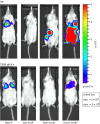Targeting ion transport in cancer
- PMID: 24493755
- PMCID: PMC3917361
- DOI: 10.1098/rstb.2013.0107
Targeting ion transport in cancer
Abstract
The metabolism of cancer cells differs substantially from normal cells, including ion transport. Although this phenomenon has been long recognized, ion transporters have not been viewed as suitable therapeutic targets. However, the acidic pH values present in tumours which are well outside of normal limits are now becoming recognized as an important therapeutic target. Carbonic anhydrase IX (CAIX) is fundamental to tumour pH regulation. CAIX is commonly expressed in cancer, but lowly expressed in normal tissues and that presents an attractive target. Here, we discuss the possibilities of exploiting the acidic, hypoxic tumour environment as possible target for therapy. Additionally, clinical experience with CAIX targeting in cancer patients is discussed.
Keywords: carbonic anhydrase IX; clinical experience; targeting; translation; tumour acidity.
Figures


Similar articles
-
New insights into the physiological role of carbonic anhydrase IX in tumour pH regulation.Oncogene. 2010 Dec 16;29(50):6509-21. doi: 10.1038/onc.2010.455. Epub 2010 Oct 4. Oncogene. 2010. PMID: 20890298 Review.
-
Hypoxia-inducible carbonic anhydrase IX and XII promote tumor cell growth by counteracting acidosis through the regulation of the intracellular pH.Cancer Res. 2009 Jan 1;69(1):358-68. doi: 10.1158/0008-5472.CAN-08-2470. Cancer Res. 2009. PMID: 19118021
-
Targeting carbonic anhydrase IX depletes breast cancer stem cells within the hypoxic niche.Oncogene. 2013 Oct 31;32(44):5210-9. doi: 10.1038/onc.2012.550. Epub 2012 Dec 3. Oncogene. 2013. PMID: 23208505
-
pH regulators and their inhibitors in tumor microenvironment.Eur J Med Chem. 2024 Mar 5;267:116170. doi: 10.1016/j.ejmech.2024.116170. Epub 2024 Feb 1. Eur J Med Chem. 2024. PMID: 38308950 Review.
-
Hypoxia inducible carbonic anhydrase IX, marker of tumour hypoxia, survival pathway and therapy target.Cell Cycle. 2004 Feb;3(2):164-7. Cell Cycle. 2004. PMID: 14712082 Review.
Cited by
-
Ion channels in cancer: future perspectives and clinical potential.Philos Trans R Soc Lond B Biol Sci. 2014 Feb 3;369(1638):20130108. doi: 10.1098/rstb.2013.0108. Print 2014 Mar 19. Philos Trans R Soc Lond B Biol Sci. 2014. PMID: 24493756 Free PMC article. Review.
-
Overexpression of Transcobalamin 1 is an Independent Negative Prognosticator in Rectal Cancers Receiving Concurrent Chemoradiotherapy.J Cancer. 2017 May 12;8(8):1330-1337. doi: 10.7150/jca.18274. eCollection 2017. J Cancer. 2017. PMID: 28638446 Free PMC article.
-
TRP Channels in Cancer: Signaling Mechanisms and Translational Approaches.Biomolecules. 2023 Oct 22;13(10):1557. doi: 10.3390/biom13101557. Biomolecules. 2023. PMID: 37892239 Free PMC article. Review.
-
OEsophageal Ion Transport Mechanisms and Significance Under Pathological Conditions.Front Physiol. 2020 Jul 16;11:855. doi: 10.3389/fphys.2020.00855. eCollection 2020. Front Physiol. 2020. PMID: 32765303 Free PMC article. Review.
-
Cancer: fundamentals behind pH targeting and the double-edged approach.Onco Targets Ther. 2016 Oct 17;9:6343-6360. doi: 10.2147/OTT.S115438. eCollection 2016. Onco Targets Ther. 2016. PMID: 27799782 Free PMC article.
References
-
- Holder JW, Elmore E, Barrett JC. 1993. Gap junction function and cancer. Cancer Res. 53, 3475–3485. - PubMed
MeSH terms
Substances
LinkOut - more resources
Full Text Sources
Other Literature Sources

